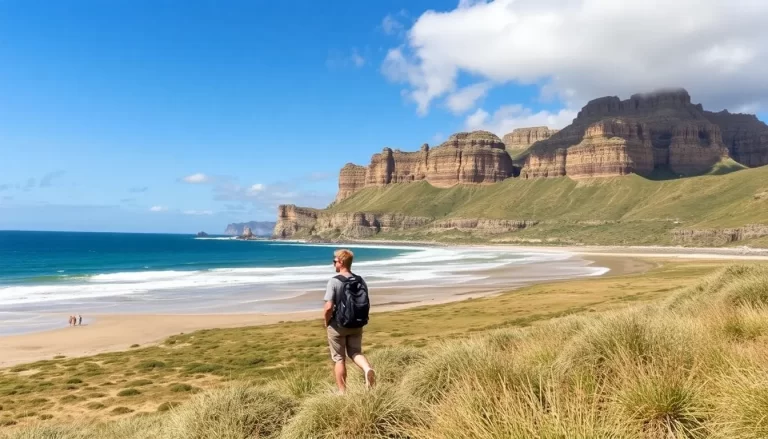As I sat in a café, bundled up against an unexpected chill, I couldn’t shake the feeling of uncertainty about my decision to visit Malta. I had come to Europe for a friend’s wedding, and instead of rushing back home, I thought spending a week exploring a new destination would be an adventurous way to start the year. With winter’s cold gripping much of Europe, I sought the warmth of the south, and Malta seemed to be the perfect choice.
However, as I shivered in layers of clothing, I realized I should have checked the weather more thoroughly. Despite being known for its mild winters, my visit coincided with an unusually cold spell. While locals assured me that conditions were typically much warmer, this did little to improve my experience.
Both my friend and I had high hopes for our time in Malta. We were determined to disconnect from our busy lives and immerse ourselves in the local culture. Yet, the frigid temperatures tempered our ambitious plans. We intended to rise early each day, but after hitting the snooze button a few too many times, our itinerary quickly fell apart.
Exploring Malta in Winter
Malta, a small archipelago in the Mediterranean, is often viewed as a summer destination. While winter offers a different charm, a week is ample time to explore the island’s highlights. Unlike the bustling beach crowds of summer, the cooler months provide a quieter experience, albeit with limited beach activities.
Despite the cold, I was captivated by Malta’s stunning landscape. The rich cultural tapestry woven over centuries is evident in its architecture and local lifestyle. From ancient ruins to charming streets, Malta offers a treasure trove of history waiting to be explored. Yet, the weather did impose some limits: I missed out on several key attractions, like the Hal Saflieni Hypogeum and the picturesque Popeye Village.
Malta’s Enchanting Atmosphere
What truly enchanted me about Malta was its people. The locals are warm, charismatic, and always eager to share a story or two. Each encounter was steeped in hospitality, revealing a deep-rooted culture that celebrates life and community. As I ventured outside the urban sprawl, I discovered the island’s breathtaking natural beauty: vineyards, rolling hills, and dramatic cliffs overlooking the azure Mediterranean.
- Charming villages with cobblestone streets
- Historical landmarks like Mdina’s catacombs
- Serene gardens such as Upper Barracca Gardens
- Rich history reflected in ancient architecture
- Stunning coastlines with sweeping vistas
One of my favorite experiences was watching the sunset from the Upper Barracca Gardens, a peaceful oasis that offered spectacular views of the harbor. I also attended mass at St. Stephen’s Church, immersing myself in the local traditions and community life.
The Stark Contrast of Malta’s Architecture
Yet, amidst the beauty of Malta, I faced a perplexing dichotomy: the presence of half-neglected buildings. Many towns appeared to be in a state of flux, with centuries-old structures reflecting a mix of Arabic and Italian influences. These architectural gems often seemed overshadowed by dilapidated buildings that had fallen into disrepair.
This contrast begged several questions:
- Why are so many buildings left unattended?
- What leads to the abandonment of such valuable real estate?
- How does the government address these safety hazards?
The sight of boarded-up houses was both haunting and intriguing. While some buildings underwent restoration, many others stood forgotten, as if waiting for someone to breathe life back into them. It was a juxtaposition that left an indelible mark on my memories of the island.
Historical Context of Malta’s Architecture
The story behind Malta’s architectural landscape is as rich as the island’s history itself. Over the centuries, various civilizations have influenced its development, from the Phoenicians and Romans to the Knights of St. John. This melting pot of cultures has resulted in a unique architectural style that reflects a blend of different eras.
Among the most striking examples of Malta’s heritage are:
- The Megalithic Temples: Some of the oldest free-standing structures in the world.
- Valletta: A city designed by the Knights of St. John, showcasing Baroque architecture.
- Mdina: The ancient capital, with its medieval streets and stunning views.
While the restoration efforts of many buildings are commendable, the existence of neglected structures raises concerns about urban development and preservation strategies. Why do some areas thrive while others fade into obscurity?
Visiting Malta: Tips for Travelers
If you’re considering a trip to Malta, here are some logistical tips to ensure a smooth journey:
- Choose the right time: While winter can be chilly, it’s also less crowded. Spring and autumn are ideal for pleasant weather.
- Book accommodations in advance: Options range from hostels to boutique hotels, catering to various budgets.
- Explore public transport: Buses are a convenient way to navigate the island and reach popular attractions.
For those venturing out, it’s essential to remain mindful of local customs and respect the rich cultural heritage that Malta embodies. Engage with locals and savor the culinary delights that reflect the island’s diverse influences.
The Future of Malta’s Heritage
The question remains: how will Malta address its architectural disparities? As tourism continues to play a significant role in the economy, the balance between preservation and modernization is crucial. Local governments and communities need to collaborate to find solutions that honor the past while accommodating future growth.
As I reflect on my time in Malta, the memories of its enchanting landscapes and vibrant culture linger. Despite the chilly weather and the mysteries of its neglected buildings, the experience was transformative. I learned to embrace spontaneity and appreciate the journey, rather than focus solely on the destination.
Although I may not return to Malta in the near future, the island’s charm and contradictions will stay with me, a reminder of the beauty found in unexpected places.







